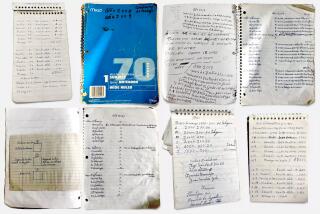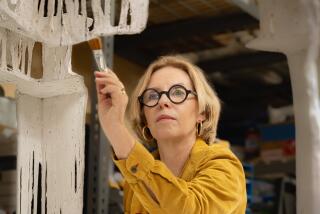Sun Rarely Sets on Papaâs Trail
SAN FRANCISCO DE PAULA, Cuba â Ava Gardner slept here, the girl says, and Gregory Peck. The elk antlers on the wall have the wingspan of a DeLorean, and keeping watch is the mounted head of the majestic great kudu that was shot on safari in Kenya, or was it Tanganyika? The girl tries to get her places and dates straight, struggling with her English.
Out back are the graves of the dogs--Black, Neron, Negrita and Linda--their names etched into headstones. She leads the way to the swimming pool, empty because the water pipeline from Havana, 12 kilometers away, is no longer connected. Yet, the electricity still functions in the house itself, where Ernest Hemingway lived, off and on, between 1939 and 1960, before the Mayo Clinic gave him the news that made him go to Idaho in 1961 and write the finish to his existence with a gun.
He wrote standing up, hovering over his manuscript. His wife tried to persuade Papa to use the office in the crowâs nest of the three-story tower constructed adjacent to the main house, even attempted to make him feel at home by spreading an ersatz lionâs-skin rug at his feet. Hemingway demurred, never using the room much, not even the telescope that offered glimpses of the Gulfstream where he fished.
âAnd this is Gregorio Fuentes,â the girl says, indicating one of the portraits on the wall.
âGregorio Fuentes?â
âOf course,â she says, as though surprised for whom this name tolled no bells. âEl viejo y el mar.â
He lives in Cojimar, she says, eight kilometers away, and he is 93 years old, and if it is more fiction than fact that Hemingway based the prize-winning adventure of âThe Old Man and the Seaâ on this particular old man, who would have been a fairly middle-aged 54 when the novel was written, Gregorio Fuentes remains convinced, in his dotage, that he was, indeed, Papaâs inspiration.
Pulling into Cojimar, a few blocks past the dunes where impoverished young villagers are sunning themselves at mid-day, one of the first older men spotted is drinking near a roadside stand from a brown paper sack. He is neither Gregorio Fuentes nor a fictitious fisherman, yet how closely his grotesque face fits Hemingwayâs description:
âThe brown blotches of his benevolent skin cancer that the sun brings from its reflection on the tropic sea were on his cheeks . . . everything about him was old except his eyes and they were the same color as the sea and were cheerful and undefeated.â
This is the village where a similarly weather-worn angler distraught at having gone 84 days without a nibble cast himself adrift to wage a war with a marlin in which one or both of them must perish. Hemingwayâs was a familiar face in Cojimar when he wasnât writing upright at the house in San Francisco de Paula, turning out the books that won him the 1953-54 Pulitzer and Nobel prizes, as well as âAcross the River and Into the Trees,â or ones that were not released until after his suicide, including âA Moveable Feastâ and âThe Garden of Eden,â plus some of his short stories.
His wife returned to the island a month after his death to donate this house to the Cuban people as a museum. The girl points to an overstuffed chair and says: âWhen he sit, he sit there, always the same chair.â
âWhy?â she is asked by someone who notices an exact duplicate chair nearby.
âBecause he was--what you call?--âcreature of habit?â â she says. âYes?â
Unquestionably. At night, Hemingway ate and passed many a pleasant hour in Bodeguita del Medio, a half-hidden cafe in one of Havanaâs many unlit alleyways. Inside, where he recounted tales of working as a correspondent during the Spanish Civil War or witnessing death in the afternoon at bloody bullfights, Papa ate platefuls of black beans and rice and washed them down with mojitos , the specialty of the house.
The waiter brings them.
âSalud! Es bueno!â he says, dispensing the drinks like medicine, as though they will be good for you.
When in Havana, you do as the Havanans do. So, down the hatch go the mojitos , a sip at a time, as replacements keep coming, no glass for long left unfilled, several ounces of rum in each along with a virtual thatch of leafy herbs that have been picked, one suspects, from the bay of twigs. With each mouthful of rum, one must spit out botanical bits.
Farther up the way, in Hemingwayâs favorite bar, another waiter asks: âLe gustaria beber algo?â And one wonders if that is the way every evening went, Papa accepting one drink offer after another, sinking deep into his cups, then returning home sometime before sunrise in time to write his books or bait his hooks. His footsteps are substantial, and one finds pleasure in retracing them, if only for one day.
More to Read
Sign up for our Book Club newsletter
Get the latest news, events and more from the Los Angeles Times Book Club, and help us get L.A. reading and talking.
You may occasionally receive promotional content from the Los Angeles Times.








